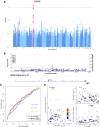Plasma Glucosylceramide Levels Are Regulated by ATP10D and Are Not Involved in Parkinson's Disease Pathogenesis
- PMID: 40022584
- PMCID: PMC12010051
- DOI: 10.1002/ana.27219
Plasma Glucosylceramide Levels Are Regulated by ATP10D and Are Not Involved in Parkinson's Disease Pathogenesis
Abstract
GBA1 variants and decreased glucocerebrosidase activity are implicated in Parkinson's disease (PD). We investigated the hypothesis that increased levels of glucosylceramide (GlcCer), a main substrate of glucocerebrosidase, are involved in PD pathogenesis. Using multiple genetic methods, we show that ATPase phospholipid transporting 10D (ATP10D), not GBA1, is the main regulator of plasma GlcCer levels, yet it is not involved in PD pathogenesis. Plasma GlcCer levels were associated with PD, but not in a causative manner, and are not predictive of disease status. These results argue against targeting GlcCer in GBA1-PD, and underscore the need to explore alternative mechanisms and biomarkers for PD. ANN NEUROL 2025;97:873-878.
© 2025 The Author(s). Annals of Neurology published by Wiley Periodicals LLC on behalf of American Neurological Association.
Conflict of interest statement
A.J., C.B., R.S., G.B., K.K.K., M.I.I., and P.B are current or previous employees of CENTOGENE GmbH, which is investigating the role of GlcCer in PD for investigational therapy development. These authors had full and complete control and access to all necessary data, and the freedom to write and publish these results independent of company oversight or right of approval.
Figures

Update of
-
Plasma glucosylceramide levels are regulated by ATP10D and are not involved in Parkinson's disease pathogenesis.medRxiv [Preprint]. 2024 Sep 16:2024.09.13.24313644. doi: 10.1101/2024.09.13.24313644. medRxiv. 2024. Update in: Ann Neurol. 2025 May;97(5):873-878. doi: 10.1002/ana.27219. PMID: 39371176 Free PMC article. Updated. Preprint.
References
-
- Gan‐Or Z, Liong C, Alcalay RN. GBA‐associated Parkinson's disease and other Synucleinopathies. Curr Neurol Neurosci Rep 2018;18:44. - PubMed
MeSH terms
Substances
Grants and funding
LinkOut - more resources
Full Text Sources
Medical

